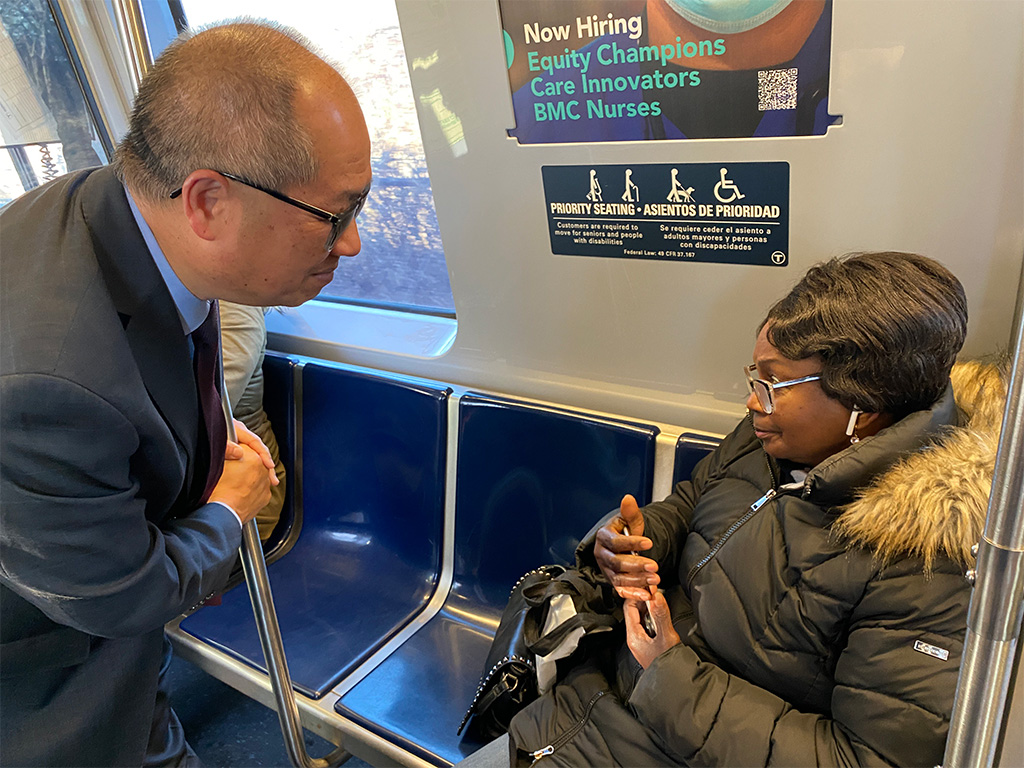Riding the T with Phillip Eng, the MBTA chief who believes the journey is also the destination

Phillip Eng, the MBTA’s new general manager, talks to a rider Monday on the blue line. (Photo: Massachusetts Bay Transportation Authority)
Phillip Eng started his first day of work like many in Greater Boston: riding the T.
Unlike many, he took a brief stop on his commute into the city at the Park Street station – he took the green line Monday – and was swarmed by a reporters asking questions. This was Eng’s first day helming the MBTA as general manager.
Eng, who plans to use the T to commute to work and get around, said he’s been riding the T for the past four years to visit his daughter, who attends Northeastern University, and on trips into Boston for business.
He also told reporters he’s been briefed on the speed restrictions on trains, and intends to dig deeper into them before releasing a schedule of corrections. With the trains whining below the surface while cars rush by on Park Street, Eng told reporters that he understand the need for speed.
“We’re all in a rush, and I understand that time is precious to everybody,” he said. “But I enjoy mass transportation. That’s why I took this role. And I want everyone else to start enjoying it too.”
“Even if there’s slow speeds right now, it’s much more relaxing,” he said. “I enjoy sitting on the train. I enjoy sitting and having that time to myself.”
Eng comes to the T after a brief stint as executive vice president of the LiRo Group, where he advised on public and private engineering, transportation and infrastructure projects, including the Massachusetts Bay Transportation Authority, on construction management and quality design, assurance and control inspections.
Eng started his career in the New York State Department of Transportation in the 1980s and worked his way up to executive deputy commissioner and chief engineer from 2013 to 2017, then became chief operating officer of the Metropolitan Transportation Authority. He served as interim president of New York City Transit moved to the Long Island Rail Road – a part of the MTA system – as president from 2018 to 2022, where he worked on hiring, scheduling and costumer relations.
It’s this experience he’s bringing with him to the T, but also a love of transit, he said.
“At my last role we had a tremendous role of hiring that we needed to be able to provide,” he told reporters about the T’s hiring shortfalls. “I know the folks are working hard on bringing on staff, and we’re going have to get [busy] and promote.”
Working for the T at any level is a fantastic career, he said, and said it’s not what most people think – “an-entry level job.”
He said the biggest barrier to a dependable system is “faith and belief … if we believe and we have faith, I know we’ll do it,” he said, adding it’s his job to empower riders and T employees, eliminating bureaucracies. “Too often in agencies over the years, we develop the processes that add time to the different things.”
Eng said he needs to dive into how the T works, revenue and infrastructure to make it work better and easier for everyone. “Fixing the infrastructure should be the easiest thing,” he said. “How we interact with the public and communities, I think that’s important too because it’s the messaging on how they understand it.”
The city of Boston has experimented with free bus routes, one of several pushes across the nation for free mass transit, but Eng deferred when asked about free rides, even as he acknowledged that mass transit has been losing revenue everywhere. He instead turned his attention to bringing riders back and referred to how “those heroes that were working every day relied on the T.”
People should be able to rely on the T every day, he said.
“Part of my reason for coming was not just the T but that the city of Boston and the state of Massachusetts has so much to offer,” Eng said. “And that’s what I want people to know. The T does not just have to be for commuting. The T can be for just using it to get out and about. It’s a fantastic way to travel and see all the different destinations that are here, and I think that’s going to be important to restoring ridership as well, right? It’s not just for the morning commute and the evening commute; it’s what you’re doing during the days and the evenings and weekends. And we’re going to promote that.”


